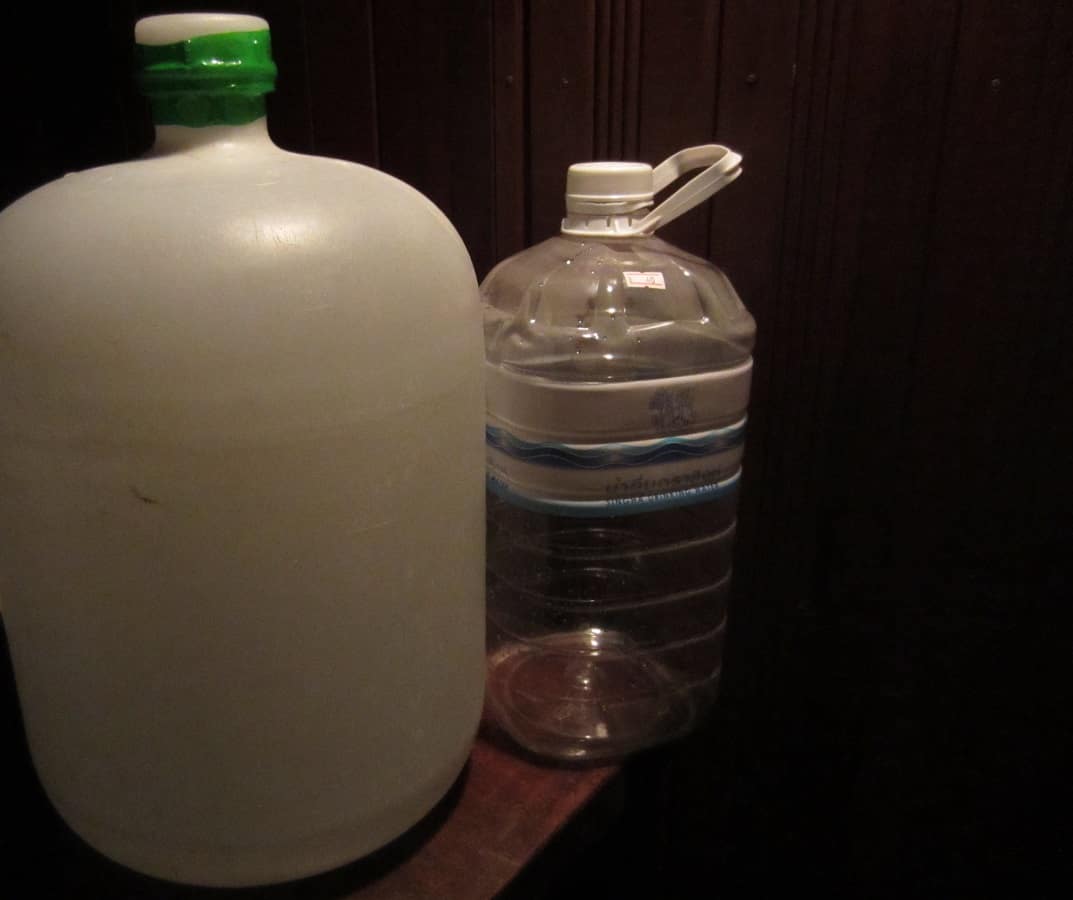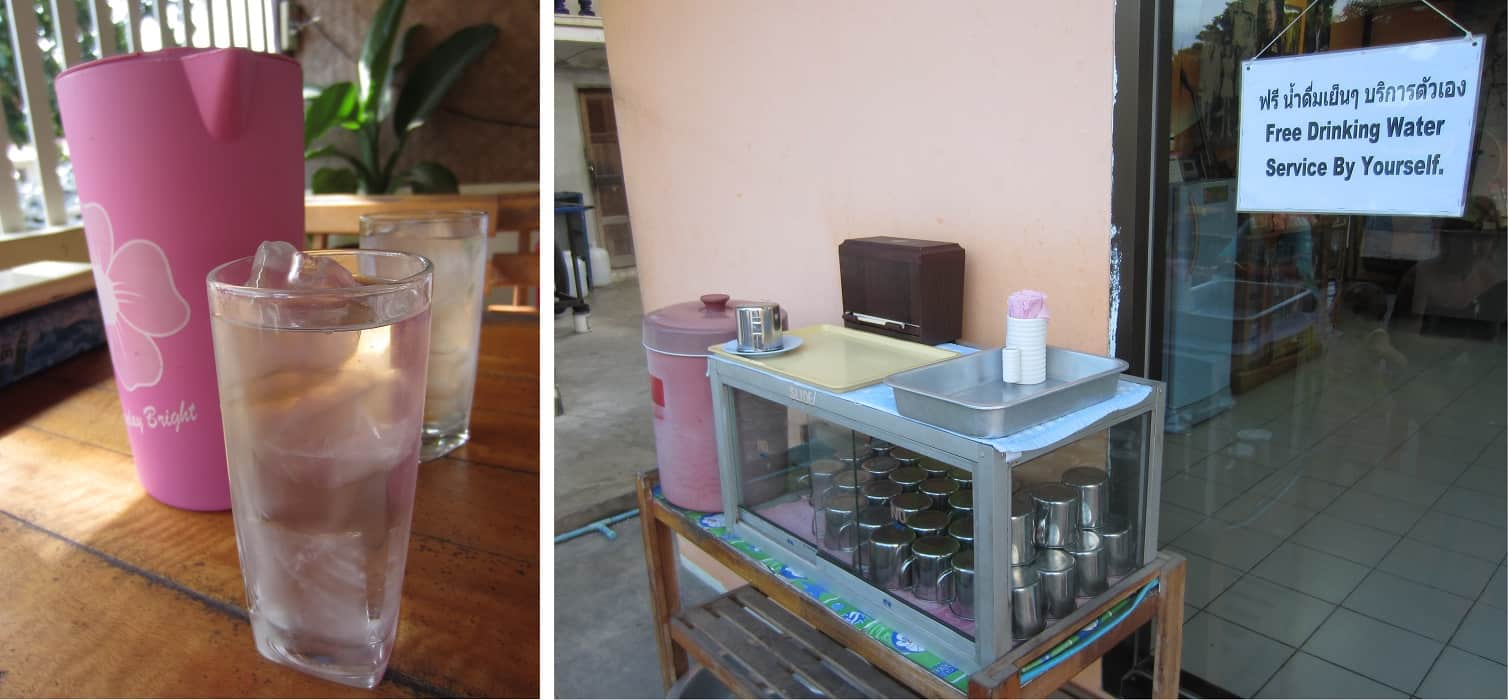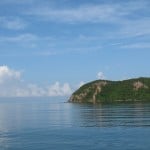Going Plastic-Free in Asia: Plastic Water Bottles
I’ve spent the last 18 months committed to avoiding unnecessary plastic. My food shopping is almost entirely plastic-free, and I especially don’t buy bottled water. Why would I, when safe drinking water comes out of my tap?
In Asia, however, the water that comes out of the tap is not safe to drink. The locals don’t drink it, and tourists shouldn’t either. When we decided to spend four weeks holidaying in Thailand at the end of last year, I really wanted to keep our plastic-free commitment and avoid buying bottled water in disposable containers. A holiday is no reason to throw our values and beliefs out the window! I just wasn’t sure how achievable it would be.
Turns out, I shouldn’t have worried! With a little bit of effort, avoiding using endless plastic drinking bottles on holiday was easy!
No expensive equipment required
Before we went away, I had a brief look at the water filters, water treatment tablets and other gadgets on the market. There’s plenty of options out there, from UV filters that zap bugs and parasites, to physical filters to remove debris, to the traditional water purification tablets. However, it’s not super straightforward. Ideally you need a bug-destroying filter and a physical filter, and the UV filters need recharging and will eventually run out. The traditional tablets involve using nasty chemicals so aren’t ideal for daily use. Plus these fancypants gadgets have fancy price labels too, and it didn’t feel right to buy more stuff that we’d use for such a short amount of time. If we had been going away for several months, or going into the wilderness maybe it would have been a worthwhile investment, but we weren’t.
And actually, we managed just fine without.
Be prepared
We didn’t buy any new gadgets, but we did take our two metal water bottles, two KeepCups and our two reusable collapsible plastic bottles – things we already had at home. I wouldn’t go anywhere in the Australian summer without taking my water bottle, so it made complete sense to take it with me.
It was a wise decision: all three were used regularly and if I went back, I’d take them all again. The bottles were useful right from when we arrived at the airport – both Perth and Bangkok airports had water filters once we’d passed through security so we could refill our empty bottles.
Make it a priority
Like most things to do with waste, it all comes down to convenience. There’s often an alternative way, even though it may require a little more effort than the conventional way. It’s all about priorities. So we prioritised, and made finding safe drinking water the first thing we did when we moved on to somewhere new.
We didn’t have too much planned when we jetted off, but I had booked our first night and last night accommodation in Bangkok, and I’d researched places that appeared to have genuine environmental policies and a focus on sustainability. This paid off: both places offered plastic-free drinking water, and we were able to refill our bottles hassle-free.
Find out what the locals do
Locals don’t drink the tap water, but they don’t all guzzle mineral water from plastic bottles either. So what do they do? In Thailand (at least in the places we visited), companies deliver treated water in big 20 litre drums to households and businesses, and the containers are returned for refilling once they are empty.
 These containers aren’t marketed to tourists, and the empty containers need returning to the seller, so some retailers were reluctant to part with them. The first place we found would only let us fill up our own containers using their funnel, so we purchased one plastic 6 litre water container and used this for refills. This was our only plastic bottle purchase of the trip! There was no way we would have managed without it, either. We used this to decant the water into our little drinking bottles so we didn’t end up spilling it everywhere.
These containers aren’t marketed to tourists, and the empty containers need returning to the seller, so some retailers were reluctant to part with them. The first place we found would only let us fill up our own containers using their funnel, so we purchased one plastic 6 litre water container and used this for refills. This was our only plastic bottle purchase of the trip! There was no way we would have managed without it, either. We used this to decant the water into our little drinking bottles so we didn’t end up spilling it everywhere.
The second place we needed to use these, we found a seller willing to give us our own bottle by paying a deposit, which we got back once we returned the empty container.

20-litre water drum with the 6-litre water bottle we had to buy. Still, that purchase meant we didn’t have to buy any more plastic bottles on our trip.
Look for alternatives
If our water bottles were empty and we were away from our base and unable to refill them, we found we still had options, and there was no need to reach for the plastic. One alternative which comes in completely biodegradable packaging is drinking coconuts. They are very hydrating, refreshing and good for you, and in Thailand, they are available everywhere.
 Lots of the cheaper Thai restaurants (which catered predominantly for locals rather than tourists) offer drinking water free of charge to patrons. We’d look out for restaurants with this service and try to use them where we could.
Lots of the cheaper Thai restaurants (which catered predominantly for locals rather than tourists) offer drinking water free of charge to patrons. We’d look out for restaurants with this service and try to use them where we could.
 We discovered that a few restaurants sold water in glass bottles that are returned to the manufacturer for refilling. We did talk about buying water at these restaurants to fill up our water bottles if we ran out, but in the end we didn’t need to.
We discovered that a few restaurants sold water in glass bottles that are returned to the manufacturer for refilling. We did talk about buying water at these restaurants to fill up our water bottles if we ran out, but in the end we didn’t need to.

We did also see some water vending machines on the streets which filled empty containers. Our only issue was that the instructions were written entirely in Thai and we couldn’t understand how they worked. If we hadn’t found any other alternatives, we’d have popped some coins in the slot to see what happened, but as it turned out, we didn’t need to use these. It’s good to know that alternatives exist, though.
Reap the Rewards
We were completely prepared to pay extra in order to avoid using plastic; we figured it was worth it to limit our impact on the environment. Usually, a higher cost is something that we have to accept for “doing the sustainable thing”. Actually, it ended up being much cheaper! The 20 litre drums of water cost less than a dollar to buy, and many places charged more for a 500ml bottle of water, particularly outside of Bangkok. It was great not to contribute unnecessarily to landfill and keep our plastic-free pledge, and awesome to save money in the process!
Two people, four weeks away, and only one plastic bottle (reused several times before being responsibly recycled). Going plastic-free is just as possible abroad as it is at home if you put your mind to it!
[leadpages_leadbox leadbox_id=1429a0746639c5] [/leadpages_leadbox]







A good effort to reduce your environmental impact while travelling.
A couple of things for people to watch out for:
– Some shops will refill bottles themselves from the tap and claim that it is filtered water.
– Watch out for ice cubes. Sometimes the ice will be made from tap water which then contaminates your filtered water.
You’re so cynical! I’m sure there are unscrupulous people out there, but I don’t think either of these things is really a problem in Thailand. The locals are aware that you shouldn’t drink from the tap, and they don’t. The refillable water containers are sealed with tamper-proof seals. Also, restaurant owners aren’t going to poison their patrons, or no-one would come back. I read that it’s always safest to choose the places that locals eat, and that are busy, so I stick to that rule. Most restaurants have barrels of the treated water all lined up, so we knew they were using safe water.
Regarding ice, the stuff in Thailand is obviously made from an industrial ice machine – you know how the shape is distinctive? Also, in one village we stayed we were actually near the place that made ice and distributed it to all the restaurants, so we saw that they used clean water with our own eyes! Very helpful!
Of course it makes sense to be alert, and to avoid things you don’t trust, but we never encountered anything suspicious.
Yes…..I’m definitely cynical, but in this case my comments are based on advice from a Thai family I was living with in Thailand some years back (perhaps things have improved in recent years). I can still recall being served a drink at a restaurant then noticing the insects and other chunky bits embedded in the ice. I have not researched this but I suspect that regular exposure to small doses of nasty bugs would build up a degree of resistance in local populations. Our whimpish western intestines are probably less able to cope with low doses of bugs.
Ew, that doesn’t sound very nice! I do totally agree, check for tampered seals and avoid anything that looks suspicious. I also think it’s different if you’re in very rural/remote areas. We were in Bangkok and the south, much more affluent areas compared to the north. As for bugs, we took probiotics with us to avoid getting any stomach problems and they seemed to work!
Hey,
Thank you for the inspiration :)
Can you tell me witch hotels you lived on and the cites in Thailand?
Keep up the good work.
We stayed at Old Bangkok Inn and Phranakorn Nornlen in Bangkok. We went to Koh Samui and stayed in the village Mae Nam, and Koh Phangan in the village of Noi Pan.
I recently went to Myanmar and found it super easy to avoid all disposable plastic water bottles too. I wrote about it on my blog also. http://www.therogueginger.com/2013/11/learning-to-travel-without-plastic.html
Hi there, just read your post, awesome work! Outside of Bangkok we did not stay anywhere luxurious enough to have a kettle (!) so we didn’t have the option of boiling. I’m glad it worked for you, though! So many options when you put a little bit of thought in : )
Inspirational! I did, unfortunately, give upmy green habits for a week in Vietnam. It’s incredibly heartening to know it’s possible to stick to your morals!
Maybe next time, eh?! It’s almost an excuse to take another holiday so you can try it out! : )
Thank you so much for this article. I try to avoid plastic packaging and this will definitely help me on my next trip!
Thanks for taking the time to read it! Good luck with your next adventure, and may it be plastic free : )
Very good example of very practical ideas and essentially doing what the locals do…
I have lived in many developing countries for many years and no one enjoys drinking dirty water – tourists, locals, anyone. The locals usually can’t afford bottle water so my advice is to ask and listen to what the locals do.
Personally I don’t carry anything more than a 1l waterbottle and some purification tablets. Most of the time I use boiled water as the locals are often very used to doing this. Other good tips are chemists, banks, high end restaurants and hotels which often have a big refillable water container and often don’t mind you filling up a litre or sometimes you have to pay for it which is fine.
In Thailand I used the public water machines like you describes and for a few cents you get a litre and for a little more you get 20l – just be careful in your selection!
Great post and I think it is very important for people to travel with their morals and habits in other places so great role-modelling!
Cheers, d’Arcy.
Do you have any suggestions for avoiding plastic completely when living in a desert town. I,m currently in UAE but soon moving to north west Kenya. Water from taps is unsafe. All safe drinking water is delivered, or in the case of Kenya, collected from the pump in plastic bottles or large plastic containers.
Hiya, I have lived in eastern Africa from time to time and I use a mix of water filters and boiling and you will be safe and plastic free…
Thanks for those suggestions, it’s good to get some advice from someone who has lived there : )
Interesting! My boyfriend went to the Dominican Republic recently for an Engineers Without Borders trip and encountered a similar situation. Since they were in a VERY rural town, they didn’t have anything like those 20-L bottles. I think they went into the city one day and got a bunch of 6-L bottles though. The locals in the rural towns wouldn’t drink the tap water, and instead they drank a lot of bottled juice, which is supposedly cheaper and more readily available than bottled water there. The juice there has a lot more sugar than juice in the US though, so a lot of people were in desperate need of dental care.
Wow. Bottled juice is so bad for you – all sugar and usually pasturised so not much goodness left. That’s rubbish. I hope you’re going to engineer them some clean drinking water?! Was the project he went to work on water-related?
It was water-related, but not drinking water-related. The town they were working in has only one road leading in and out, and during the rainy season the road floods in 4 different places, badly enough that no one can get in or out of the town for days or even weeks at a time. That means no fresh food, no bottled juice, no school, and no hospital access. Two of those river crossings already have bridges, and his EWB project is to build bridges at the other two crossings. His specialty is civil engineering and water resources management, so flooding and bridges is right up his alley.
Hi! I’m planning a South East Asia trip in January and your post was SO SO helpful! I’m so happy to know I can do it plastic-free
Monica! I do not know how I missed this (which is now 2 years old!) but of course I enjoyed following your trip on Instagram and am glad I was able to help :) And of course you did great!
I do not agree with this statement. I know if you remain in touristic areas of developing countries they have addressed the issue in many ways that are possible. However, I do work in the villages in the developing word and none of these exist or are possible. I am seriously looking for a way to not use plastic water bottles and agree these fancy gadgets are not a good substitute. In fact, many places I would be nervous drinking the local water that often comes from streams and rivers with no treatment and looks it even when treated by these devices. Parasites are really problematic. That is why I am doing the work.
Hi Suni and thanks for your comment. I’m not quite sure which statement you disagree with, but I’m going to make a guess and assume it’s the one about being able to go abroad and avoid plastic. I wasn’t being scientific about it of course – I was meaning that for most tourists planning on going to places that have some level of tourist infrastructure, there will be options.
Clearly Asia is a huge continent and there are places that are very remote, which rely on plastic or maybe don’t have potable water at all. Please don’t take this out of context. It was not meant as a generalised statement but as encouragement for those holidaying in Asia and hoping to reduce their impact.
Hopefully the work you do will enable more places to go plastic-free whist having safe drinking water :)
I returned from Thailand a few weeks ago and I used a wide mouth thermos for take away smoothies etc – the vendors did think I was strange at first but i just said “plas-a-tic” (plastic in Thai) no good” and they seemed to agree! The more of us that refuse plastics there the better, more alternatives will become more common!
Are there any issues taking metal drink bottles and straws through airport security?
Great blog. Check out fill2pure. No chemicals and clean drinking water anywhere in the world. My partner and I have used in south east Asia with no issues. Just fill up from the tap and away you go. Filter last ages too!!!